Irina Komissarova is a young Moscow-born stage designer who has lived in Lithuania for many years. From 2017 to 2020, she worked with award-winning director Oskaras Koršunovas, founder in 1998 of the Oskara Koršunovo Teatras (OKT) Vilnius and considered the heir to the great pillar of Lithuanian theatre, Eimuntas Nekrošius. She was struck by his scrupulous work on the text and ability to directly extract scenographic elements from it. Thus, having noticed that Koršunovas did not have a permanent set designer while working with the same composers, choreographers, and light artists, she proposed herself for the role.
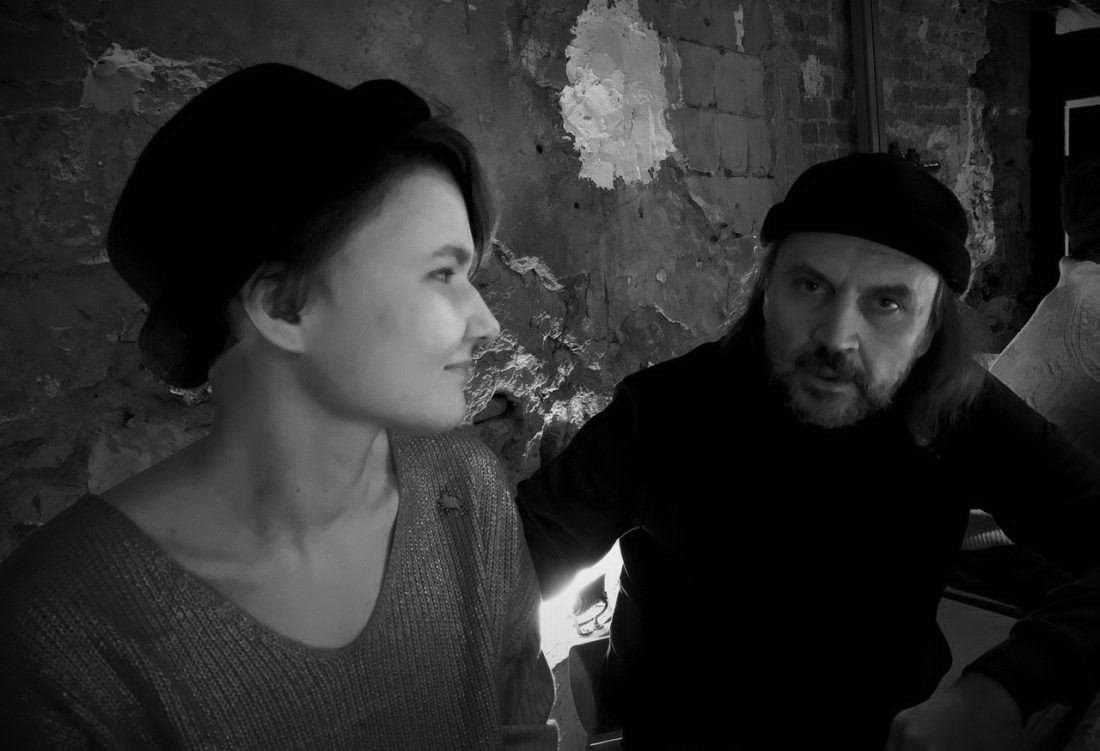
Koršunovas’ method for creating the scenes, as Komissarova says, is that of a «universal Meccano»: he starts with a first basic element, which he identifies before letting the set designer access the material to enrich it. For the collaborator, this is a real «leap into the void» because, after an initial approach of clarification with the director, they are alone and have the reins of the visual project, all the responsibility for the scene, and must make decisions.
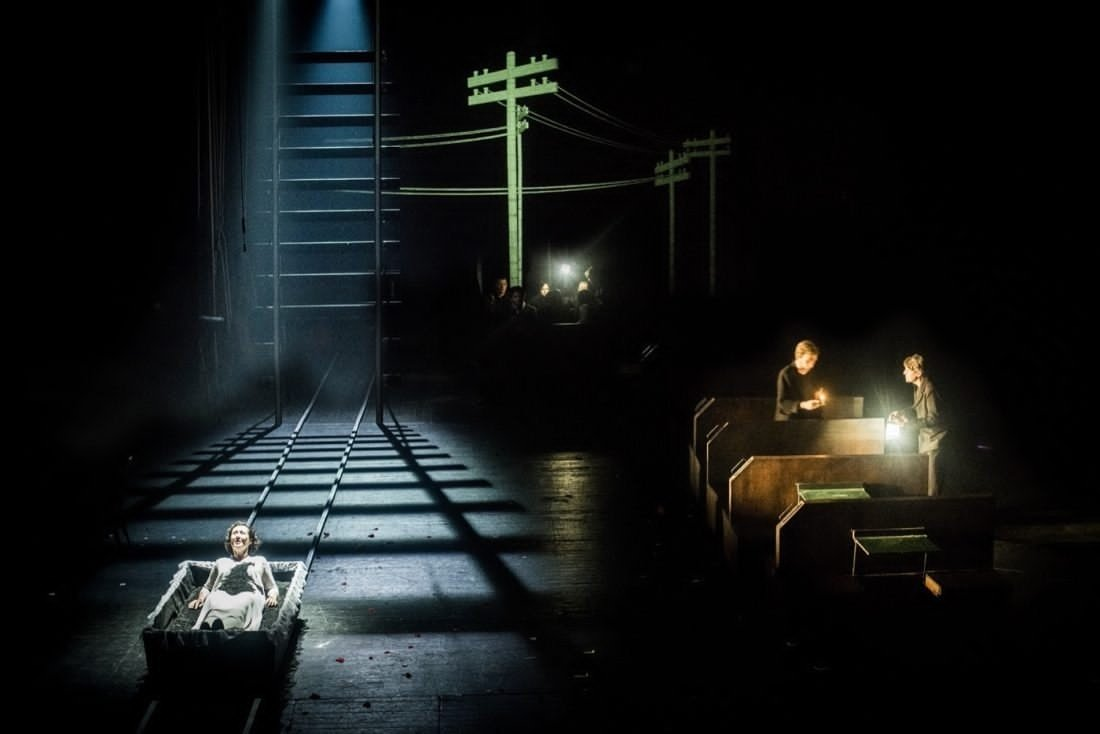
Komissarova collaborated with Koršunovas on Russian Novel (2018) based on the play by Marius Ivaškevičius, one of Lithuania’s leading contemporary playwrights. The play dwells on the story and last months of life of a world famous Russian novelist Lev Tolstoy (1828-1910). In the centre of the play is writer’s wife Sofia Andrejevna, her fate and life upon turning into the wife of a world-class genius. This is also Koršunovas’ first production to include a video projection conceived as a space continue by a set designer.
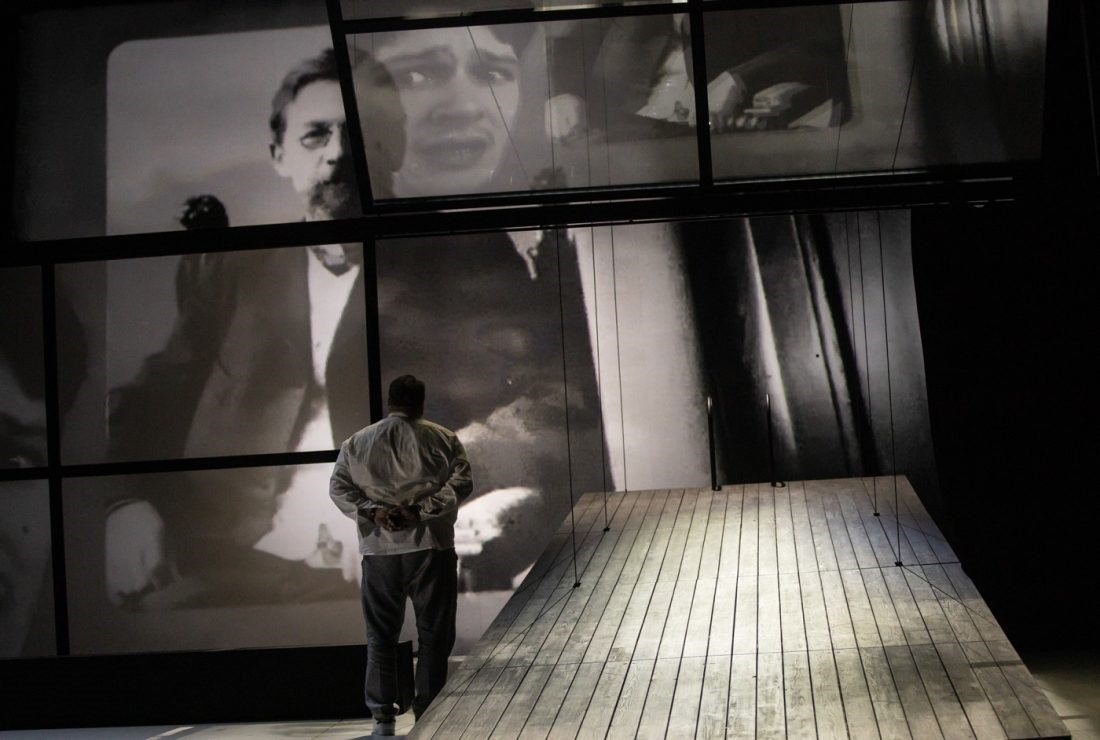
Komissarova also worked on the 2020 re-release of The Seagull for the Moscow Art Theatre, the birthplace of the historic The Seagull production directed by Konstantin Stanislavsky in 1898. Koršunovas’ is the fifth edition of the work to be produced and performed in the illustrious Russian theatre. His first version from 2014, produced for the Vilnius theatre, has become a classic already, and, in the director’s intentions, it was to be the third chapter of a trilogy after Hamlet and The Lower Depths. For the 2020 version, Koršunovas did not want to change the articulation of the scenes and confirmed almost all of the components from the previous production. However, there was no professional set designer in the first edition since the stage was intentionally devoid of decorative elements, and some details had therefore been defined by the light designer. But the Lithuanian director remembered having seen some of Komissarova’s productions and how she used video on stage, particularly in his city theatre OKT (Oskaras Koršunovas’s Theatre). So he called her to use a similar method for The Seagull.
We met Irina Komissarova and asked her to tell us about her training and artistic journey between Lithuania and Europe, as well as her experience with her collaboration with Gian Maria Tosatti at the Summer Festival of Arts “The Access Point”.
Anna Maria Monteverdi: When did you start your theatre studies?
Irina Komissarova: I was a twenty years old student of Interior and Environmental Design when I began working as the personal assistant to a theatre expert who was the PR coordinator of several well-known international theatre festivals in Moscow. Finally, that line of work with theatre critics convinced me to change my specialisation thus I became a scenographer.
I was born and raised in Moscow, a city with many world-famous theatres and their schools. However, I chose to pursue my studies in Vilnius in Lithuania as a place to study scenography. I had the delightful opportunity once to bear witness to a rehearsal of Eimuntas Nekrošius and that acted as the catalyst that began my journey.
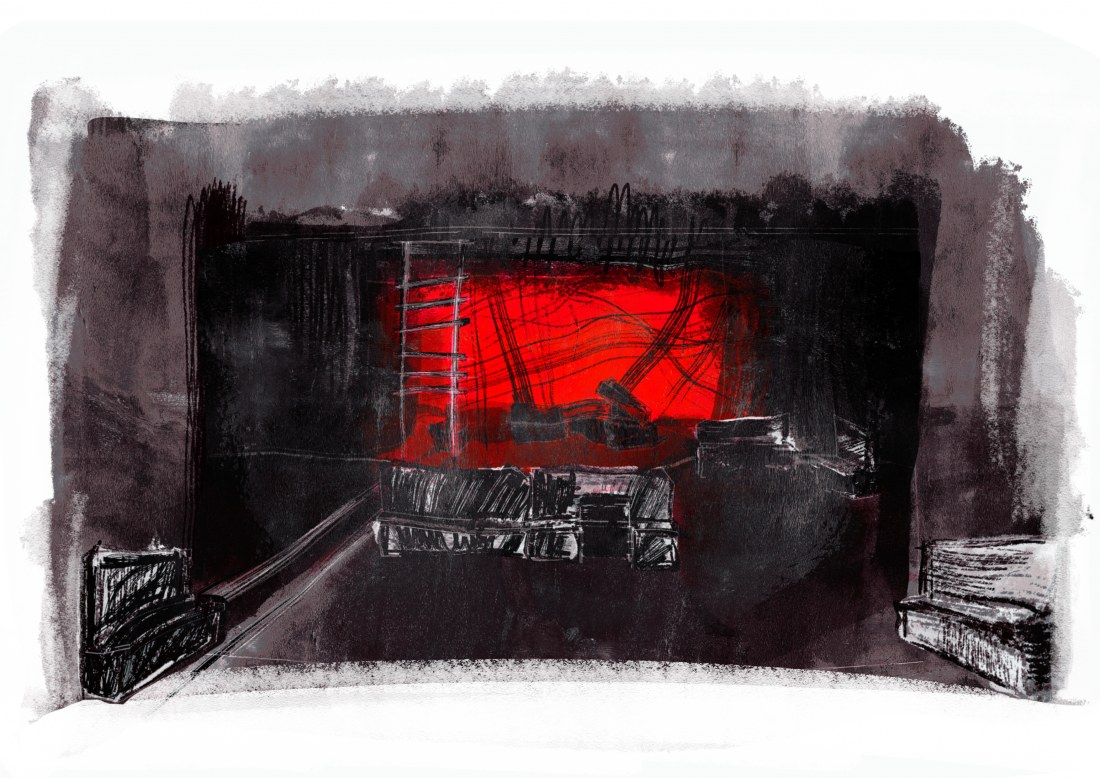
As I was in my early twenties, it made moving to Lithuania relatively easy, as I enrolled as a scenography student at the Vilnius Academy of Arts (VAA). To my great surprise, there wasn’t as strict an academic program as the one I was used to in Russia. For the first time in my young life, I was not told what to study; everything was up to me and what I chose to focus on. I also was not a student of only one specific professor like the one in the Russian theatre system in which a significant amount of knowledge you get depends on your professor’s (we also refer to them as ‘master’) personality, intellect, interests or priorities and we had to adapt to their own personal methods of thinking and working. In VAA, I had four professors who taught me many different aspects of scenography in drama, Opera, costume history, puppetry and theatre of objects. One of my teachers, Adomas Jacovskis, had worked with Nekrošius in his earlier performances before becoming the co-author of Rimas Tuminas’s shows. I’m grateful that I had the chance to learn from several generations of well-renowned Lithuanian scenographers.
A. M. M.: With whom did you start your first work in theatre design in Lithuania?
I. K.: My first work in theatre was a play based on Cervantes’s novel Don Quixote. It was the BA final project of young director and Koršunovas’s assistant Agnija Leonova. The story was set in Vilnius, the old town streets. It was performed at a typical ‘black box’, but later we adapted the production to a site-specific version. Shortly after graduation I spent a year as a general set designer at Mogilev drama theatre (Belarus). I received that offer from another Lithuanian director Saulius Varnas, a disciple of the legendary Juozas Miltinis. My work with Oskaras Koršunovas began in 2017 and lasted three years. In parallel, I worked with Agnija Leonova on a performance at OKT studio (Oskaras Koršunovas’s Theatre).
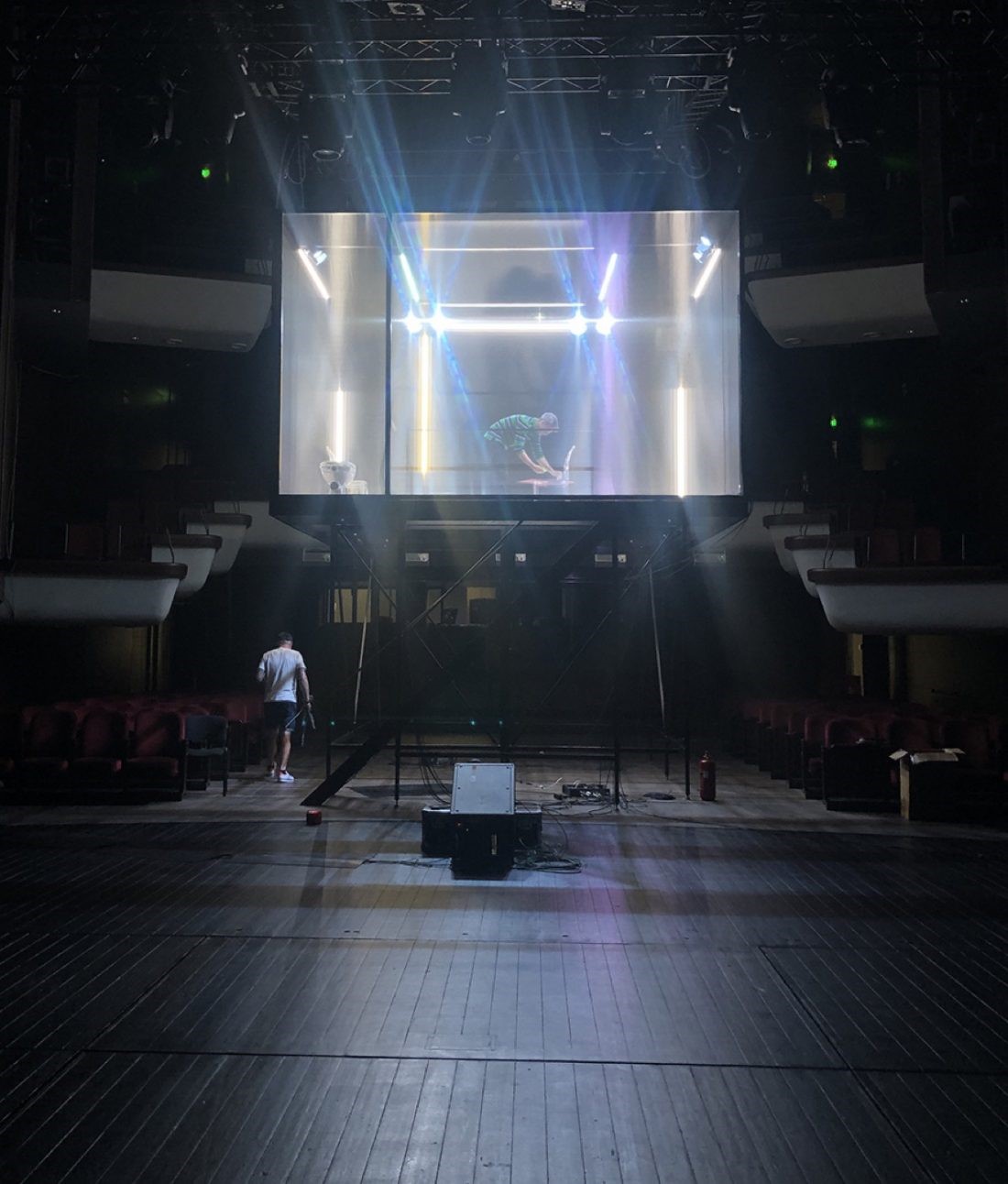
My solutions for the small space in the old town of Vilnius impressed Oskaras even more than our work in Russian romance. Using simple materials such as glass and projection film, I created a set that ‘broke’ the small space’s walls. Right after that, Koršunovas asked me to join him on other projects, and one of them was The Seagull at the Čechov Moscow Art Theatre (called MXT), at the theatre, bearing the name of Anton Čechov and using his Seagull as a brand.
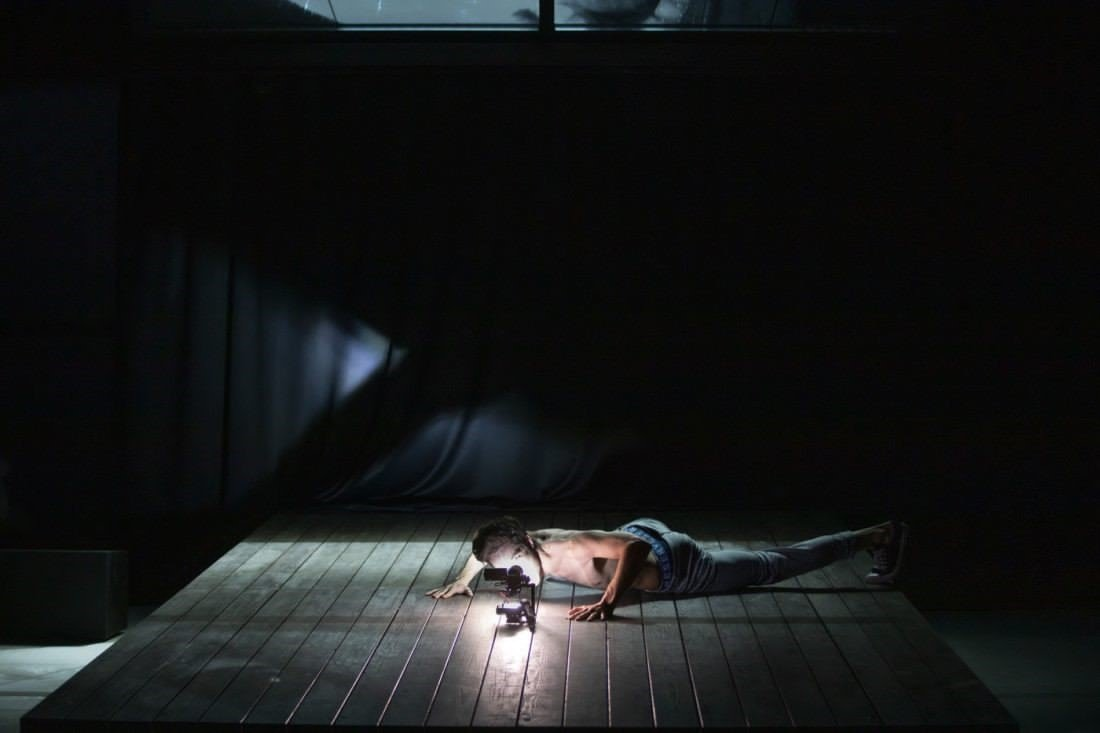
Technically, it wasn’t the first Seagull for Oskaras. He surely took a lot from his first show in Vilnius, but it is an entirely different production. He asked me to work with a visual structure of his first idea but in another sense. I had to create a modern house of Moscow’s elite with their references, such as a bridge to a lake on a big screen on the horizon, a projection glass screen that looked so attractive to Oskaras at OKT studio. Not for the first time, I got inspired by architecture. I tried to use different structures but finally kept only the frames and floor. I laid down principles of modular design into those constructions to be able to add or cut one module to fit the set into any other smaller or bigger stage. To convey the idea of a lake, I added a few pool ladders and put one of them in front of the audience making the auditorium become a lake too. Also, the stage level in MXT is not comfortable for all stalls and Oskaras asked to think about it too. I not only raised the floor, but I also mirrored it at the same tilt angle as at stalls - 3º. That small detail which was very popular in theatre architecture in the 19th century opened the full view on stage. Still, when Oskaras was ready to approve the set project, I wasn’t perfectly happy with the outcome yet. The space was so clean and looked too inanimate to me. So I added some details.
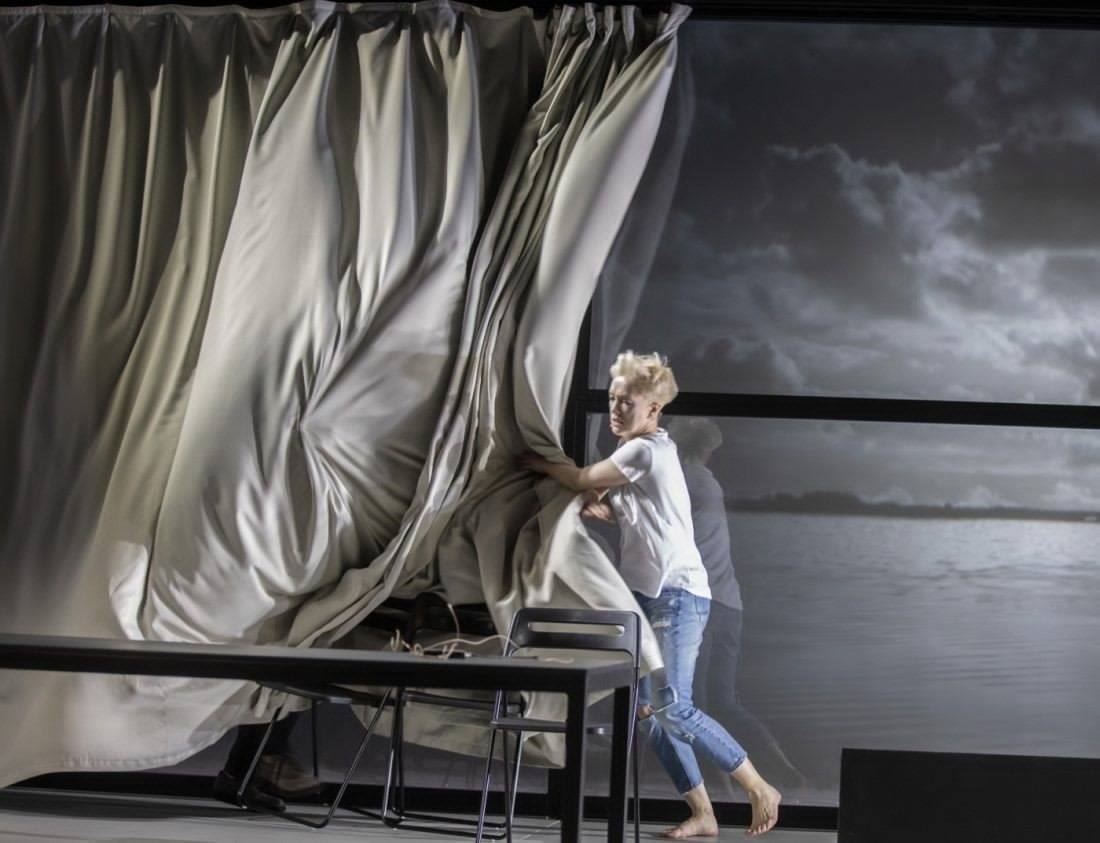
There were roller monumental bunches and curtains in three colours: white for the beginning, red for the middle, and black for the end of the play. I was surprised, but the curtains gave us a new character. We had nothing that could remind us about Vilnius’s Seagull at the end except for the director’s name. So I love both versions but for different reasons.
Working in small studios or with modest budgets, I knew where, how, and using what materials I would build my sets. So when I started working at MXT, I knew all the specific details about my future set with high precision. But here, for the first time, I worked with a team of theatre technologists and an engineer constructor with whom we calculated all constructions and built a unique moving bridge. According to my idea, the bridge should quietly move up all the time. It was a very technical and elegant solution, but it wasn’t used in the performance to my regret. However, I promised myself that I would make time to study theatre technologies and construction design one day. Then, during the first quarantine, I started studying as a theatre technologist. Time flies. Now I’m working on my diploma where I’ve already designed my own technical and elegant construction.
A. M. M.: You have started a collaboration with Gian Maria Tosatti recently. Can you tell us about the working method and the differences between Tosatti and Koršunovas?
I. K.: I have worked with Gian Maria Tosatti in two different times in 2019 and 2021 in the framework of the Summer Festival of Arts “The Access Point”. When I met him, he was working on an ongoing project called My Heart is a Void, The Void is a Mirror (2018-). The spaces chosen by him were those of conflict, civil wars, where freedom is threatened and identity is silenced. That really resonated with me. In 2021 he started The Border Lab and the main principle of it was the study of borderline states in art. It took place in Ivangorod, a city at the Russian-Estonian border zone. Here, with other performers, composers, directors, and artists, we were supposed to make our observations and according to them create our own visual dramaturgy.
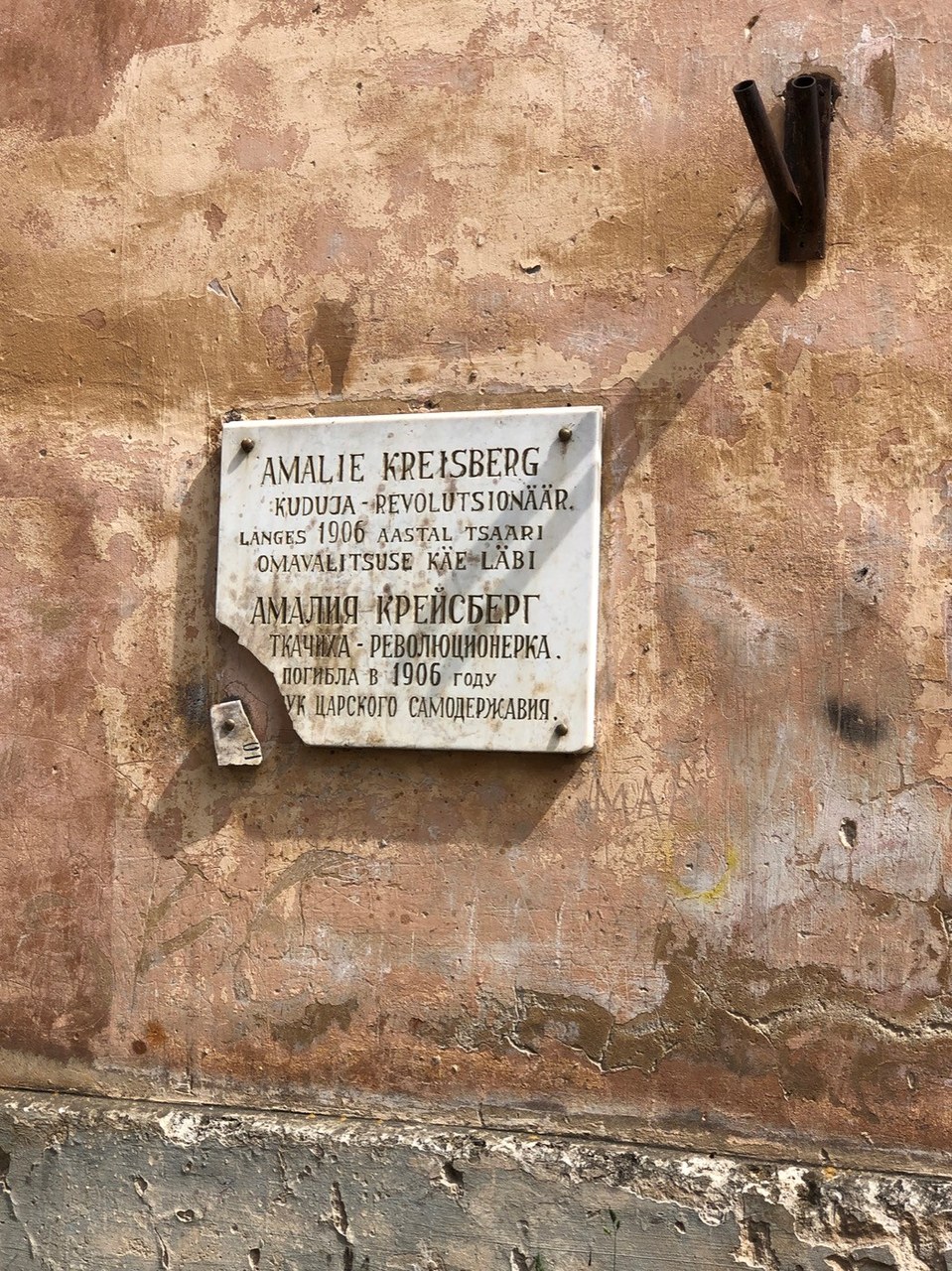
In a historical part of Ivangorod, close to The Kreenholm Textile Manufacture company, there was a half-abandoned building with a commemorative plaque about a young revolutionary woman who was killed. There was a dark hall with boarded-up windows on the first floor. In contrast, the second floor looked bright and full of air. After exploring the whole building, I found a room with many paving stones and neatly stacked lumber at the darkest corner of the first floor. From the dusty walls and ceilings of this decrepit old home, my story about Kreenholm’s very own female revolutionary who may have lived here was born.
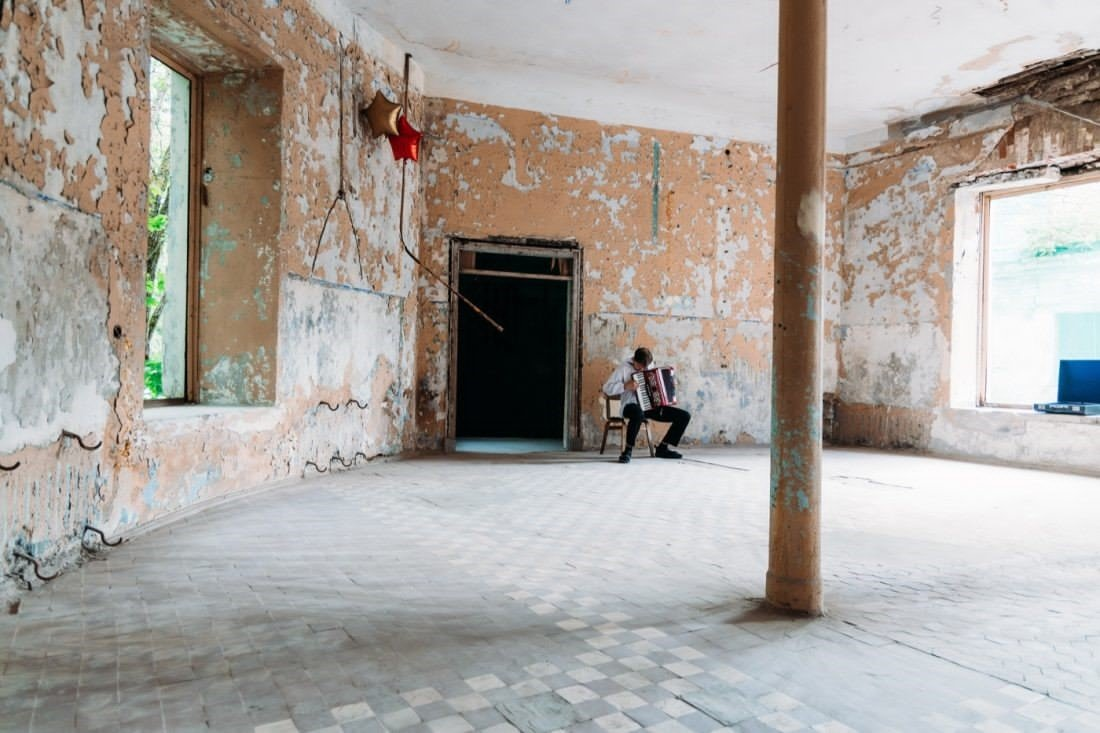
Tosatti and I, along with a group of four other artists, began writing the story about the anniversary of a woman. A woman who, more than 100 years ago, fought to defend human and women’s rights. A woman whose name has been shamefully forgotten and story has been just a part of Soviet propaganda. The idea was to show the ritualistic anniversary of the life and death of a woman without any connection to reality. The audience would start their journey from the commemorative plaque. Once inside the building, they would find themselves at the bottom of the stairs and faced with a soviet style poster going up to the second floor, where they would see a lonely accordionist tuning his instrument. Moving from the brightly lit second floor back down to the much darker first, they move into the last and final room where they are then faced with yet another commemorative plaque... One with the name: Amalie Kreisberg. Maybe she could live or die there one day. Or not – nobody remembers –.
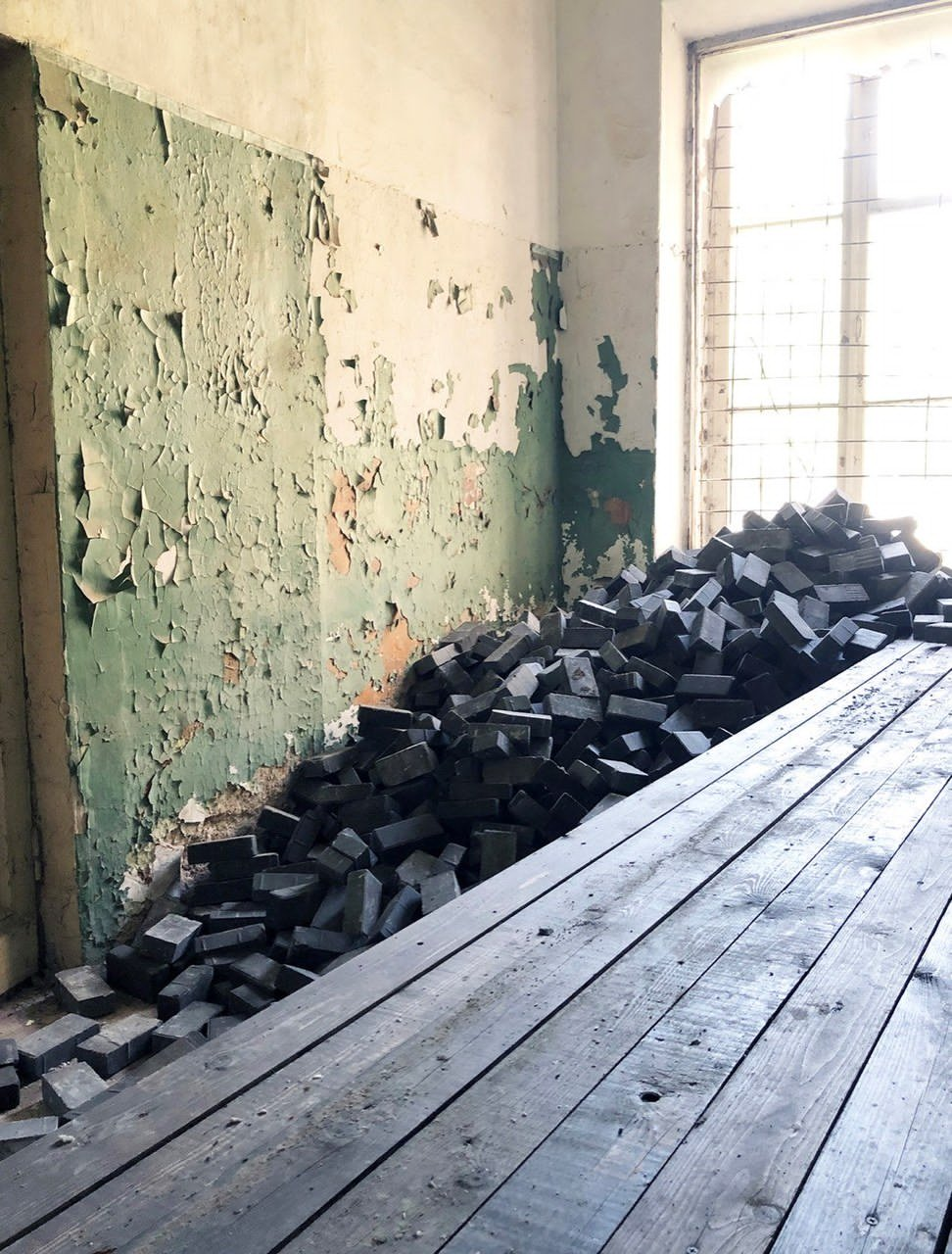
It was part of a seven-hour performance The Day of the City by Gian Maria Tosatti and twenty young artists. Together it looked like rips in time on the borderline between two worlds, between Russia and the UE. The project as a whole received good reviews. As for my own part in the project, under my direct leadership and responsibility, I helped create one of the project’s most complex and intricate episodes. An episode not only depicting the sacrifices and lives lost by those women brave enough to rise and be the voices of the voiceless, but also one of lessons that have yet to be learned to this very day.
When I was working with Koršunovas I learned from him. I still feel a strong connection with his theatre, but I was in the role of his assistant. In contrast working with site specific I found that even as a scenographer I can have a more independent role. Tosatti affected my artistic way as strongly as Nekrošius many years ago. I’m inspired by Tosatti’s example. As many years before I believe I’m standing at the threshold of an important and new phase of my life.